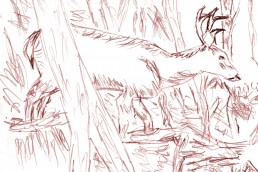The Story of the ‘Ghost Deer’
SHARE THIS POST
A few years ago, my life changed a tad. I could no longer hunt with my traditional recurve bow. Arthritis took me aside and said, “You can no longer practice enough to shoot critters with that bow. I no longer allow it.” So it has been. My traditional bowhunting for deer is over.
I was not ready to do the crossbow, then, and still am not. Consequently, I can only deer hunt during the gun seasons. I can say seasons because, often, I hunt all of the gun seasons with one gun. It’s an old-time, .50-caliber, percussion cap Hawken (I only have to clean one gun that way). With this gun, I hunt the nine-day, regular gun season; the ten-day, muzzleloading season, and, if there is one for the area I hunt, the special, four-day, antlerless-only season. That is 23 days available for deer hunting with a gun.
In addition to that, I hunt in a zone that allows hunters to take doe, if that is their desire. Not everyone enjoys killing a doe. I will if the opportunity is right—meaning an adult, in close, after midseason.
Actually, all of my shots have to be close with the gun I use. My range is about 50 yards. That is better than with the recurve bow, but not anything like the modern muzzleloaders. Those can be sighted in up to 200 yards.
So, even with the short-range handicap, I still had 23 days to put some venison in the freezer. What can be the problem?
Well, did I say there was a problem? Why don’t I just give you an overview of what happened that season? Then you tell me. (By the way, I also learned a valuable lesson I will tell you about later.)
A season in the spotlight
November. Opening morning. Fog. Thick fog. The drive to my hunting place takes an additional 20 minutes – normally, it is only a 30-minute drive.
I take what I think I need for a day in the woods and proceed to the ground blind I set up four days earlier. I walk slow and silently through the soggy woods. I can almost see where I am going. Good thing I am familiar with these woods.
Twenty minutes after I settle in, I can see enough to put the percussion cap on the nipple of the Hawken. I am now ready.
A few distant shots are heard, and I wonder how anyone can shoot in that fog. “They must all have scopes,” I think to myself – knowing you can see better with good optics in dim light or even fog. (I do not have a scope on my gun, but I do have a good pair of binoculars hung around my neck.)
Maybe 15 minutes into the legal shooting time, to my left, I see some hazy movement. The fog is still heavy. I bring up my binoculars and see a nice mature doe. She looks my way, turns, then moseys off, passing about 40 yards behind my blind. She fades in and out of the fog—ghostlike. Sometimes I see her…sometimes I don’t.
Ten minutes later, another misty shape moves along the same path the doe traveled, its nose to the ground. A buck. I can’t tell if it is a nice fork horn or a small six pointer. I shift position and slowly bring the gun up. The buck never slows down. He is intent on finding that doe. (Obviously, the rut is still on and his hormones are reacting accordingly.)
Are you enjoying this post?
You can be among the first to get the latest info on where to go, what to use and how to use it!
I follow it the best I can. It too fades in and out of the fog. The conditions offer no opportunity for a clean shot, so I pass.
I lower the Hawken and resume my watch.
About 45 minutes later, the fog is now somewhat thinner, a second buck appears. It does not have its nose to the ground. It is just ambling along. It is big, even in the fog. Its rack (antlers) has low tines, but is wide. It uses the same trail as the other deer, but at a slower pace.
Experiencing technical difficulties
I raise the smokepole slowly. The fog does not allow a clear target right away. I line up the sights and follow the deer as it moves along. The buck enters a small shooting lane where the fog is light. I squeeze the trigger. The cap fires, but the powder which propels the ball out the barrel to the target, does not.
As quick as possible, I remove the exploded cap and put on a new one. Apparently, the buck hesitated at the sound, because when I look up it has not vanished. It is still moving along the trail. The buck approaches an opening that gives me one final opportunity. I line up the shot and squeeze the trigger. Again the cap goes off, but the powder does not.
The buck continues on its way, unscathed.
I dig into my possibles bag for my nipple wrench. I remove the nipple, put a few grains of blackpowder under the nipple, replace the nipple and say to myself, “It won’t misfire again.”
Although I hunted hard and often during the rest of the three seasons, in a variety of non-deer hunting weather, the only deer I saw during the entire 23 days were those “ghostly whitetails.”
So, did I have a problem? You tell me.
What did I learn? Now, I always fire two caps before loading the gun. Once loaded, I unscrew the nipple and put a bit of blackpowder under the nipple. I have never had a misfire since.
By the way, if any left-handed, traditional archers are out there and would like to discuss obtaining my Bruin recurve and everything that goes with it for a very reasonable price, contact me through my website, jerrykiesowoc.com. It would make a great Christmas gift.
MWO
SHARE THIS POST
You may also like...
Did you enjoy this post?
You can be among the first to get the latest info on where to go, what to use and how to use it!
Jerry Kiesow
Jerry Kiesow enjoys all aspects of the outdoors and shares them in many ways through his photos, words and workshops. He has written two books, Tales of The Peshtigo Putzer and Photos, Poems, and a Little Bit of Prose, that make great gifts. Check it all out at his website: jerrykiesowoc.com.


